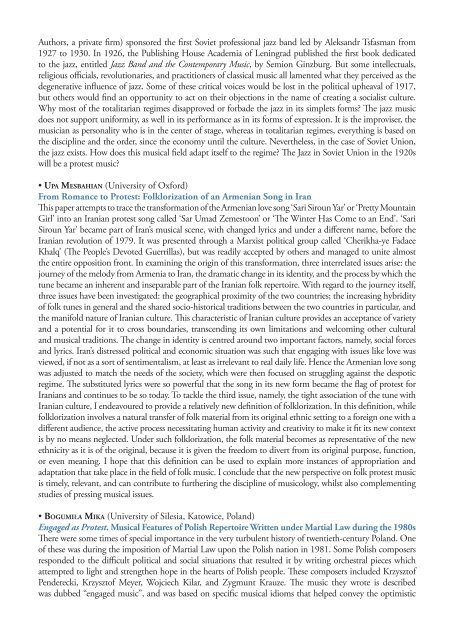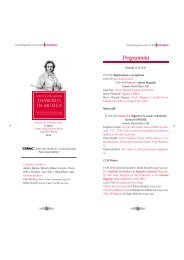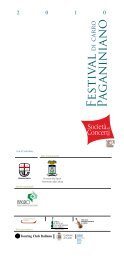PROGRAMME - Centro Studi Opera Omnia Luigi Boccherini
PROGRAMME - Centro Studi Opera Omnia Luigi Boccherini
PROGRAMME - Centro Studi Opera Omnia Luigi Boccherini
You also want an ePaper? Increase the reach of your titles
YUMPU automatically turns print PDFs into web optimized ePapers that Google loves.
Authors, a private firm) sponsored the first Soviet professional jazz band led by Aleksandr Tsfasman from1927 to 1930. In 1926, the Publishing House Academia of Leningrad published the first book dedicatedto the jazz, entitled Jazz Band and the Contemporary Music, by Semion Ginzburg. But some intellectuals,religious officials, revolutionaries, and practitioners of classical music all lamented what they perceived as thedegenerative influence of jazz. Some of these critical voices would be lost in the political upheaval of 1917,but others would find an opportunity to act on their objections in the name of creating a socialist culture.Why most of the totalitarian regimes disapproved or forbade the jazz in its simplets forms? The jazz musicdoes not support uniformity, as well in its performance as in its forms of expression. It is the improviser, themusician as personality who is in the center of stage, whereas in totalitarian regimes, everything is based onthe discipline and the order, since the economy until the culture. Nevertheless, in the case of Soviet Union,the jazz exists. How does this musical field adapt itself to the regime? The Jazz in Soviet Union in the 1920swill be a protest music?• Upa Mesbahian (University of Oxford)From Romance to Protest: Folklorization of an Armenian Song in IranThis paper attempts to trace the transformation of the Armenian love song ‘Sari Siroun Yar’ or ‘Pretty MountainGirl’ into an Iranian protest song called ‘Sar Umad Zemestoon’ or ‘The Winter Has Come to an End’. ‘SariSiroun Yar’ became part of Iran’s musical scene, with changed lyrics and under a different name, before theIranian revolution of 1979. It was presented through a Marxist political group called ‘Cherikha-ye FadaeeKhalq’ (The People’s Devoted Guerrillas), but was readily accepted by others and managed to unite almostthe entire opposition front. In examining the origin of this transformation, three interrelated issues arise: thejourney of the melody from Armenia to Iran, the dramatic change in its identity, and the process by which thetune became an inherent and inseparable part of the Iranian folk repertoire. With regard to the journey itself,three issues have been investigated: the geographical proximity of the two countries; the increasing hybridityof folk tunes in general and the shared socio-historical traditions between the two countries in particular, andthe manifold nature of Iranian culture. This characteristic of Iranian culture provides an acceptance of varietyand a potential for it to cross boundaries, transcending its own limitations and welcoming other culturaland musical traditions. The change in identity is centred around two important factors, namely, social forcesand lyrics. Iran’s distressed political and economic situation was such that engaging with issues like love wasviewed, if not as a sort of sentimentalism, at least as irrelevant to real daily life. Hence the Armenian love songwas adjusted to match the needs of the society, which were then focused on struggling against the despoticregime. The substituted lyrics were so powerful that the song in its new form became the flag of protest forIranians and continues to be so today. To tackle the third issue, namely, the tight association of the tune withIranian culture, I endeavoured to provide a relatively new definition of folklorization. In this definition, whilefolklorization involves a natural transfer of folk material from its original ethnic setting to a foreign one with adifferent audience, the active process necessitating human activity and creativity to make it fit its new contextis by no means neglected. Under such folklorization, the folk material becomes as representative of the newethnicity as it is of the original, because it is given the freedom to divert from its original purpose, function,or even meaning. I hope that this definition can be used to explain more instances of appropriation andadaptation that take place in the field of folk music. I conclude that the new perspective on folk protest musicis timely, relevant, and can contribute to furthering the discipline of musicology, whilst also complementingstudies of pressing musical issues.• Bogumiła Mika (University of Silesia, Katowice, Poland)Engaged as Protest. Musical Features of Polish Repertoire Written under Martial Law during the 1980sThere were some times of special importance in the very turbulent history of twentieth-century Poland. Oneof these was during the imposition of Martial Law upon the Polish nation in 1981. Some Polish composersresponded to the difficult political and social situations that resulted it by writing orchestral pieces whichattempted to light and strengthen hope in the hearts of Polish people. These composers included KrzysztofPenderecki, Krzysztof Meyer, Wojciech Kilar, and Zygmunt Krauze. The music they wrote is describedwas dubbed “engaged music”, and was based on specific musical idioms that helped convey the optimistic









